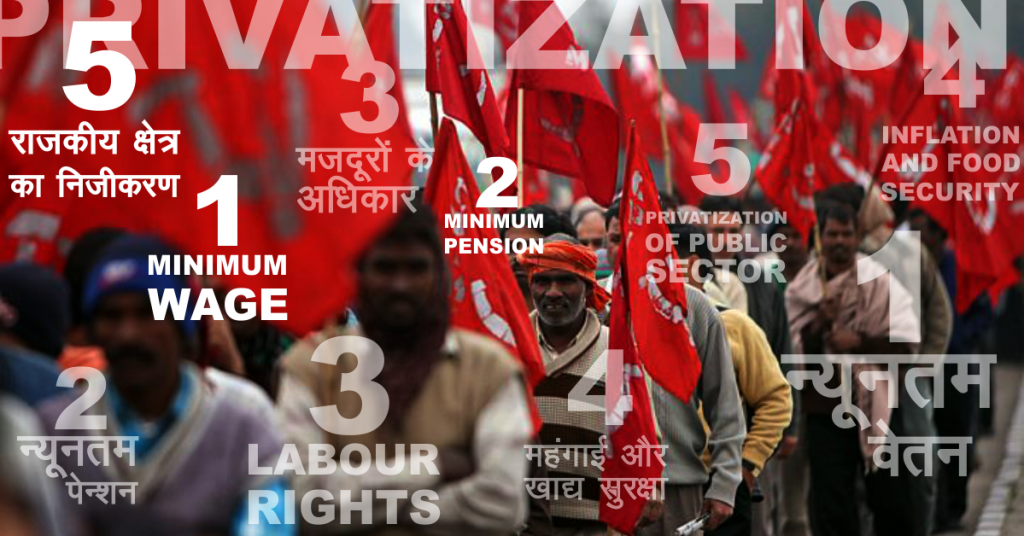Today nearly 1,00,000 workers from across India are beginning to arrive in the nation’s capital as a part of Mahapadav, a protest against the perceived anti-labour and anti-people policies of the government. In an exclusive video interview to Citizens for Justice and Peace, Vivek Monteiro, Secretary, Centre of Indian Trade Unions, shares the various demands of the workers and how they feel they are being given a raw deal by the government.
“The movement may be by workers, but our struggle is actually for the common man,” says Vivek Monteiro setting the tone for the wave protest that begins in New Delhi on Nov 9. Workers from the organised as well as the unorganised sector and those who work in the public sector will arrive in New Delhi every day and present their different demands to the central government. “Contract workers from Ciat Tyres, Rashtriya Chemical Fertilizers (RCF), BPCL, HPCL and BARC will join the protest. Domestic workers, Anganwadi workers as well as hawkers are also joining the protest,” he elaborates. Even white collar workers from the banking and insurance sectors are expected to join the protest. “There are significant economic issues we want to raise as these affect workers,” he says. Here are their key demands:
Minimum Wages
The first demand of the workers is that of a minimum living wage. “The workers are demanding a minimum wage of Rs 18,000/- per month. Given how everything is getting increasingly expensive, it is difficult to afford even basic necessities of life for any family. Frankly even Rs 18,000/- is not enough,” says Monteiro. In fact, according to the Raptakos Brett criteria of the Indian Labour Conference, a living wage is actually closer to Rs 25,000/- per month.
Universal Pension
The second major demand relates to social security where the workers are demanding a universal pension of Rs 3,000/- per month for every Indian over the age of 60. This is because a lot of workers are employed in the unorganised sector and don’t get gratuity or other benefits when they retire or can’t work due to poor health or disability.
Roll Back of proposed labour codes
The workers are also deeply disappointed with the labour codes proposed by the government and demand an immediate roll back of these codes. “If they want to change any labour laws, we should have tripartite talks between representatives of industry, labourers as well as government,” suggests Monteiro.
Need to control inflation and provide food security
The workers are also disappointed by the government’s inability to control inflation. They feel the pinch in the absence of any real food security. “Prices of pulses, tomatoes and onions keep fluctuating and often become unaffordable for the poor,” says Monteiro. “The profits are reaped by large traders like Adani Wilmar and ITC!”
Rethink Privatisation
The workers also fear the privatisation of public sector undertakings. “Take the example of the Indian Railways. Today we have some of the most affordable railway tickets in the world, but this shameless government wants to privatise profitable rail lines and large stations,” he fumes. “Not just the transport sector, even the energy sector including coal mines, oil wells etc. are all set for disinvestment,” he says.
On the subject of the decline in the popularity and influence of trade unions Monteiro has a cautious approach. “While it is true that factories have shut down and been replaced by real estate projects in cities like Mumbai, it is a little premature to dismiss Mumbai’s working class,” insists Monteiro. “There are factories that are still operational in the industrial belts of neighbouring Thane-Belapur region as well as in the whole host of new industries such as the IT sector, real estate and construction workers etc., that have come to Mumbai,” he explains. He also says the factories that moved out of Mumbai have been relocated in other parts of the country. “Chemical plants have moved to Ankleshwar, pharmaceutical plants have moved to Baddi. So one cannot say that the working class is disappearing in India,” he asserts.
“Till about five years ago various workers and labourers unions were affiliated with different political parties and did not have a united platform. But they came together and that’s how we are able to mobilise such a huge protest,” he says explaining how trade unions are still strong and relevant. He also says that the movement is intersectional and includes voices from different communities and castes. “It’s not just the red flag these days, there’s the tricolour, the blue flag and until 2013 the Bharatiya Mazdoor Sangh was also a part of our struggle. But they parted ways when the Modi government came to power,” says Monteiro.
Explaining the sense of disillusionment that workers feel today, Monteiro says, “People are beginning to see that the Modi government is not acting in their best interest and the promise of ‘achchhe din’ has not come true for the common man. It is only large corporate houses who have benefitted.”
Photo: Socialism.in
Illustration by Amir Rizvi

